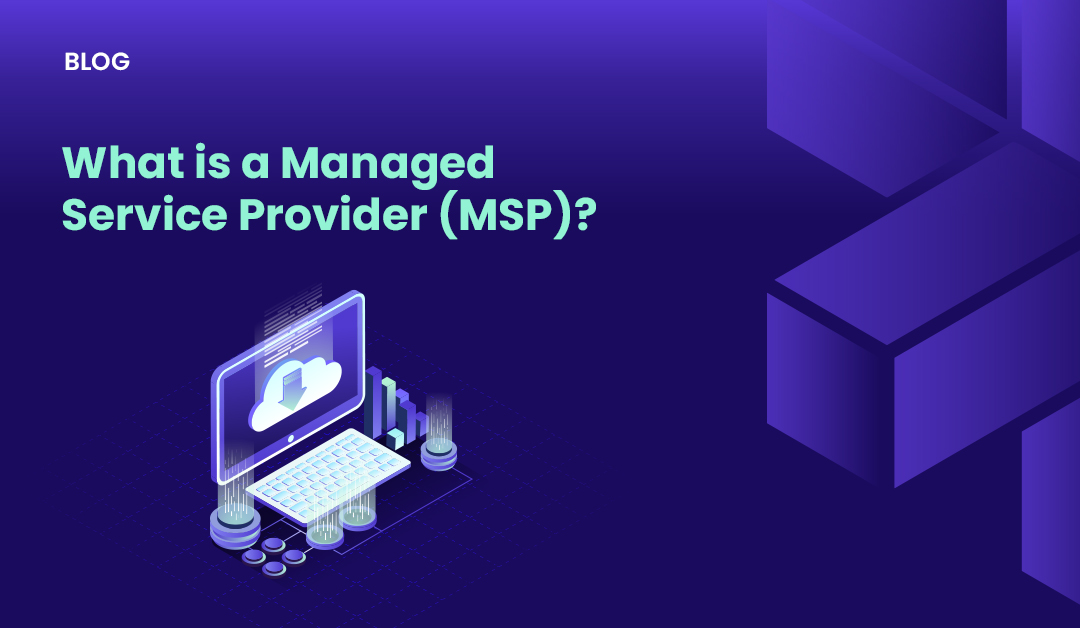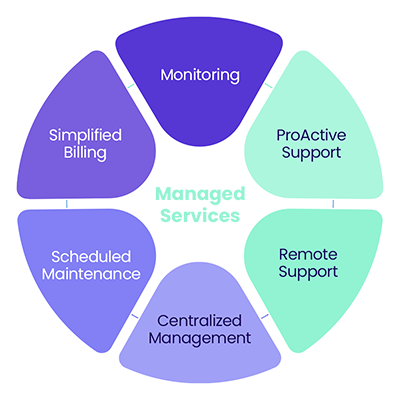What is a Managed Service Provider (MSP)?
In today’s highly competitive business world, it might be too costly for a business to cover all its IT needs in-house. The requirements and regulations on network infrastructure and security, monitoring, and remote or hybrid work models could stretch the IT team’s resources to the limits. Under these circumstances, even large enterprises and government entities may need […]
Author
Date
Category
All Categories
- AI-powered security
- Attacks & Threats
- Cybersecurity
- Hybrid Cloud
- Network
- Network Firewall
- Network Protection
- News
- Remote Workforce
- Security
- Zero Trust
Contents
Popular Posts
Product
Join the Newsletter

In today’s highly competitive business world, it might be too costly for a business to cover all its IT needs in-house. The requirements and regulations on network infrastructure and security, monitoring, and remote or hybrid work models could stretch the IT team’s resources to the limits. Under these circumstances, even large enterprises and government entities may need to turn to Managed Service Providers (MSPs). The right MSP could bring the needed expertise and specialization into IT operations and may turn the business’ technology headaches into strategic advantages.
A Managed Service Provider is a third-party company that remotely manages its customer’s information technology (IT) infrastructure and end-user systems. Small and medium-sized businesses (SMBs), for-profit enterprises, nonprofits, and government agencies hire MSPs to perform a defined set of day-to-day management services. These services may include network and infrastructure management, security, and monitoring. MSPs often handle management services on a daily basis so customer organizations can focus on their core business without worrying about extended system downtimes or service interruptions.
However, not all MSPs are created equal. An MSP that supports hundreds of clients hugely differs from one that serves a handful of global conglomerates. You need to find the right one for your company size, network architecture (what you have today and what you would like to have in the future), culture, and budget.
What does an MSP do?
MSPs typically offer a wide range of IT services to their clients, helping them setup, configure, manage, optimize, and secure their infrastructure and devices. Some of the common services the MSPs provide include:
- Set up, configure, and maintain infrastructure and various networks layered upon it.
- Providing cybersecurity services to protect the organization from cyber threats and bad actors.
- Remote Monitoring and Management (RMM) to ensure the clients’ networks perform well as they are supposed to.
- Helpdesk support to end-users to deliver services such as network and application troubleshooting, employee onboarding / off-boarding, and other assistance.
- Managing wireless and mobile devices (both corporate-owned and BYOD)
- Cloud services such as managing software and cloud configurations, storage and computing resources, and data and application migrations.
- Vendor management on behalf of the corporation.
- Business Continuity and Disaster Recovery services (BCDR)
- Strategic IT consulting and planning to help clients plan for the future and align their technology architecture with their business plans.
Types of Managed Service Providers by scale and scope of services
- Boutique (or small) MSPs
Typically, these are smaller MSPs that serve a local market and/or focus on delivering a specific set of services (e.g., cybersecurity). They may manage a limited number of end devices overall and depend on word-of-mouth and peer-to-peer relationships to grow their business.
- Midsize MSPs
These tend to be larger than boutique MSPs with more mature organizations and a larger client base. They may have a regional or nationwide presence and may specialize in specific industry verticals.
- Enterprise-level MSPs
These are large MSPs that have a multi-national or global presence, offering a broad and comprehensive set of services. They may have gone through multiple rounds of private equity funding, and roles in the organization are established and mature. They most likely have multiple divisions that serve their clients by industry verticals or technology.

Pricing Models
Selecting a pricing model is not just a budgeting exercise but a strategic decision for your business.
Let us explore the most common pricing models preferred by MSPs today:
1. Per-device: Simplicity is at the core of this model. By charging a flat fee for each type of device covered under the contract, MSPs offer clarity to clients. This straightforward approach allows businesses to easily comprehend costs and adjust their monthly fees as they scale up their device count.
2. Per-user: In an era where one user may operate multiple devices, this model offers a flat fee per user per month, covering all IT needs. It’s particularly advantageous for customers with several devices, providing them with a cost-effective solution.
3. Value-based: Imagine having an entire outsourced IT department at your disposal for a flat fee. That’s what the value-based model offers. It addresses not only immediate issues but also anticipates future needs, ensuring comprehensive IT service coverage. Contract negotiations for this type of pricing could be complex.
4. Monitoring-only: This model provides essential monitoring and alerting services for those on a tight budget. It’s the epitome of a ‘bare minimum’ approach, with the option to extend assistance for an additional fee.
5. Tiered: Flexibility is paramount in the tiered model, where different service packages cater to varying customer needs and budgets. From basic remote support to emergency after-hours assistance, there’s a package for every requirement level. This model tends to be flexible, but be careful about choosing low-cost options and understand what exactly they provide before you sign up.
6. All-you-can-eat buffet: Predictability is crucial for budgeting, and this model delivers just that. A monthly flat fee includes remote support, onsite support, and lab time, eliminating billing fluctuations and simplifying financial planning.
7. A la carte: Customization meets client preference in this model, allowing you to select specific services tailored to your unique needs. While MSPs less favor it due to its complexity, this could be the right option for you as the customer.
When it comes to selecting the right pricing model for Managed Service Provider (MSP) offerings, the stakes are high. The decision you make today will shape your business’s financial landscape and define the quality of your partnership with an MSP. It is not a choice to be made lightly or without due diligence.
Consider this: the services you require from an MSP are as unique as your organization. For instance, if your needs are project-based and irregular, a la carte or per device could be your best bet. This allows you to pay only for the work done without committing to ongoing fees. Conversely, if you’re looking for continuous support and maintenance, the value-based or tiered model can offer the stability and predictability your budgeting process demands.
Predictability in costs is not just about comfort; it’s about strategic planning. A flat-rate or fixed-fee model simplifies financial forecasting, enabling you to allocate resources confidently. However, if your organization experiences ebbs and flows in demand, a pay-as-you-go or tiered pricing model might be more suitable, offering scalability that aligns with your varying requirements.
Risk tolerance is another critical factor. The question is, how much risk are you willing to shoulder alongside your MSP? If you are unsure, an all-you-can-eat buffet may be your best bet. In contrast, if you have the resources to handle the issues in a timely manner, what you may need is only monitoring.
Service Level Agreements (SLAs) are the backbone of any MSP contract. They must be scrutinized to ensure compatibility with your chosen pricing model. Without well-defined SLAs, measuring your MSP’s performance becomes guesswork, which is unacceptable when your operations depend on their service.
Transparency cannot be overstated. Whichever pricing model you lean towards, it should bear all costs. Both parties need to understand what is being paid for and why. This clarity prevents disputes and ensures that neither side encounters unpleasant surprises down the line.
The frequency and depth of communication required between you and your MSP also influence the pricing model selection. Time and materials models, for example, typically necessitate closer collaboration, while fixed-fee models allow for a more autonomous approach. Your internal capacity for engagement will guide you toward the appropriate level of interaction.
Ultimately, the right pricing model for your MSP services hinges on your organization’s specific needs and preferences. Engage in candid conversations with potential MSPs, solicit customer references, and weigh the long-term implications of your partnership. Flexibility in negotiation and a comprehensive grasp of contractual terms are indispensable in aligning the pricing model with your objectives.
How can MSPs Enhance Their Clients’ Security Posture?
MSPs can enhance their clients’ security posture mainly by two ways:
-
Through the services they offer
-
Through the technology stack they build, maintain and use to deliver their services
Some of the MSP services to enhance cybersecurity include:
-
Conducting risk assessments and security audits to identify vulnerabilities
-
24/7/365 network monitoring and response
-
Managed security services such as firewall management, intrusion detection and prevention, end-point protection, and implementing new architectures such as zero trust
-
Incident response plan development and training, for pre, during and post-event responses
-
Patch management pon network devices
-
Multi-Factor Authentication (MFA) implementation and maintenance of it
-
Data backup and recovery
-
Compliance management
The Technology Stack:
Each MSP builds and manages a technology stack that will help it deliver its services. The MSPs build their stacks based on their clients’ needs and their own future plans. They test their technology stack, maintain it (e.g., making sure the most recent software releases and patches are in) to make sure everything works effectively and efficiently. They are always on the lookout for newly developing security technologies that will help them and their clients fight the bad actors.
The technology stack can be software-only (SaaS model), or hardware+software (hybrid model), although the latter is more likely (it helps, at least, to have the options for hardware). For example, Timus’s zero-trust architecture is a 100% SaaS solution, but when an MSP integrates it into its tech stack, it may add a hardware option to its offering to accommodate some clients that may not have an additional port to connect to at their Network Operations Centers (NOC).
Conclusion
In conclusion, choosing the right MSP is not merely a fiscal or operational exercise—it’s a strategic decision that affects every facet of your relationship with your service provider. Whatever service model you opt for, remember that this decision sets the tone for your partnership. Approach it with the seriousness it deserves, armed with insight and a clear vision of your goals. Your business depends on it.
Get Started with Timus
Zero Trust. Adaptive Cloud Firewall. Secure Remote Access. In one.
